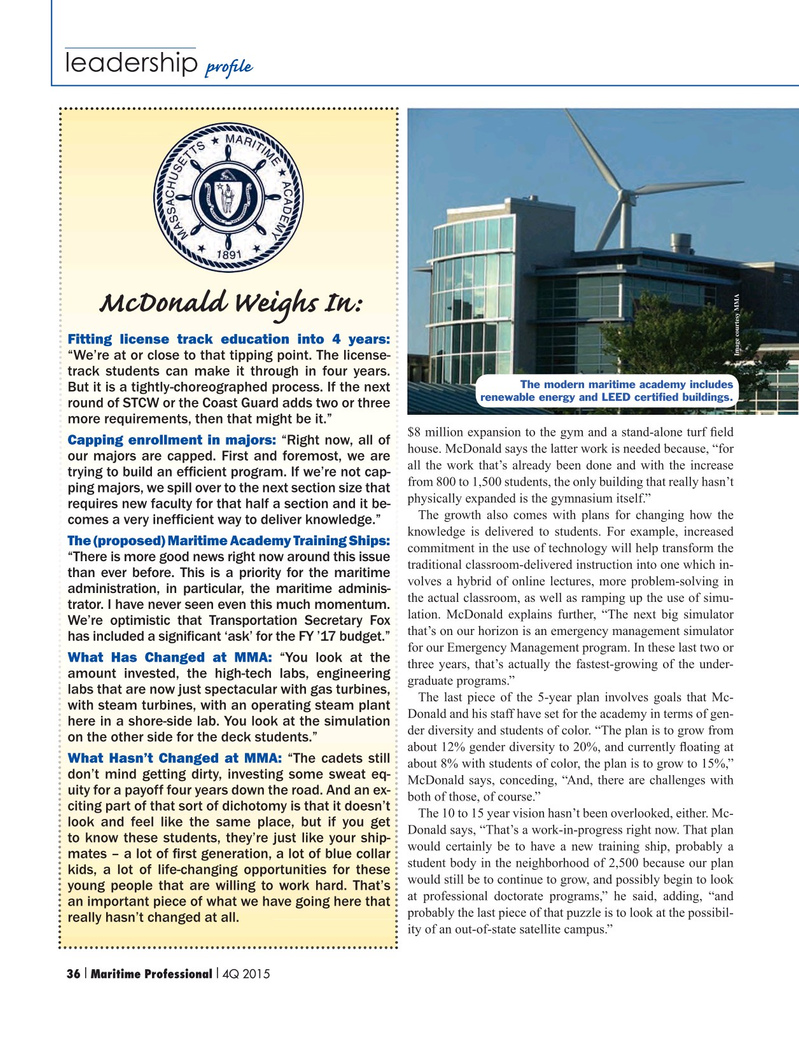
Page 36: of Maritime Logistics Professional Magazine (Q4 2015)
Read this page in Pdf, Flash or Html5 edition of Q4 2015 Maritime Logistics Professional Magazine
leadership pro? le
McDonald Weighs In:
Fitting license track education into 4 years:
Image courtesy MMA “We’re at or close to that tipping point. The license- track students can make it through in four years.
The modern maritime academy includes
But it is a tightly-choreographed process. If the next renewable energy and LEED certi? ed buildings. round of STCW or the Coast Guard adds two or three more requirements, then that might be it.” $8 million expansion to the gym and a stand-alone turf ? eld
Capping enrollment in majors: “Right now, all of house. McDonald says the latter work is needed because, “for our majors are capped. First and foremost, we are all the work that’s already been done and with the increase trying to build an ef? cient program. If we’re not cap- from 800 to 1,500 students, the only building that really hasn’t ping majors, we spill over to the next section size that physically expanded is the gymnasium itself.” requires new faculty for that half a section and it be-
The growth also comes with plans for changing how the comes a very inef? cient way to deliver knowledge.” knowledge is delivered to students. For example, increased
The (proposed) Maritime Academy Training Ships: commitment in the use of technology will help transform the “There is more good news right now around this issue traditional classroom-delivered instruction into one which in- than ever before. This is a priority for the maritime volves a hybrid of online lectures, more problem-solving in administration, in particular, the maritime adminis- the actual classroom, as well as ramping up the use of simu- trator. I have never seen even this much momentum. lation. McDonald explains further, “The next big simulator
We’re optimistic that Transportation Secretary Fox that’s on our horizon is an emergency management simulator has included a signi? cant ‘ask’ for the FY ’17 budget.” for our Emergency Management program. In these last two or
What Has Changed at MMA: “You look at the three years, that’s actually the fastest-growing of the under- amount invested, the high-tech labs, engineering graduate programs.” labs that are now just spectacular with gas turbines,
The last piece of the 5-year plan involves goals that Mc- with steam turbines, with an operating steam plant
Donald and his staff have set for the academy in terms of gen- here in a shore-side lab. You look at the simulation der diversity and students of color. “The plan is to grow from on the other side for the deck students.” about 12% gender diversity to 20%, and currently ? oating at
What Hasn’t Changed at MMA: “The cadets still about 8% with students of color, the plan is to grow to 15%,” don’t mind getting dirty, investing some sweat eq-
McDonald says, conceding, “And, there are challenges with uity for a payoff four years down the road. And an ex- both of those, of course.” citing part of that sort of dichotomy is that it doesn’t
The 10 to 15 year vision hasn’t been overlooked, either. Mc- look and feel like the same place, but if you get
Donald says, “That’s a work-in-progress right now. That plan to know these students, they’re just like your ship- would certainly be to have a new training ship, probably a mates – a lot of ? rst generation, a lot of blue collar student body in the neighborhood of 2,500 because our plan kids, a lot of life-changing opportunities for these would still be to continue to grow, and possibly begin to look young people that are willing to work hard. That’s at professional doctorate programs,” he said, adding, “and an important piece of what we have going here that probably the last piece of that puzzle is to look at the possibil- really hasn’t changed at all.
ity of an out-of-state satellite campus.” 36 Maritime Professional 4Q 2015
I I 34-49 Q4 MP2015.indd 36 11/18/2015 9:43:15 AM

 35
35

 37
37
